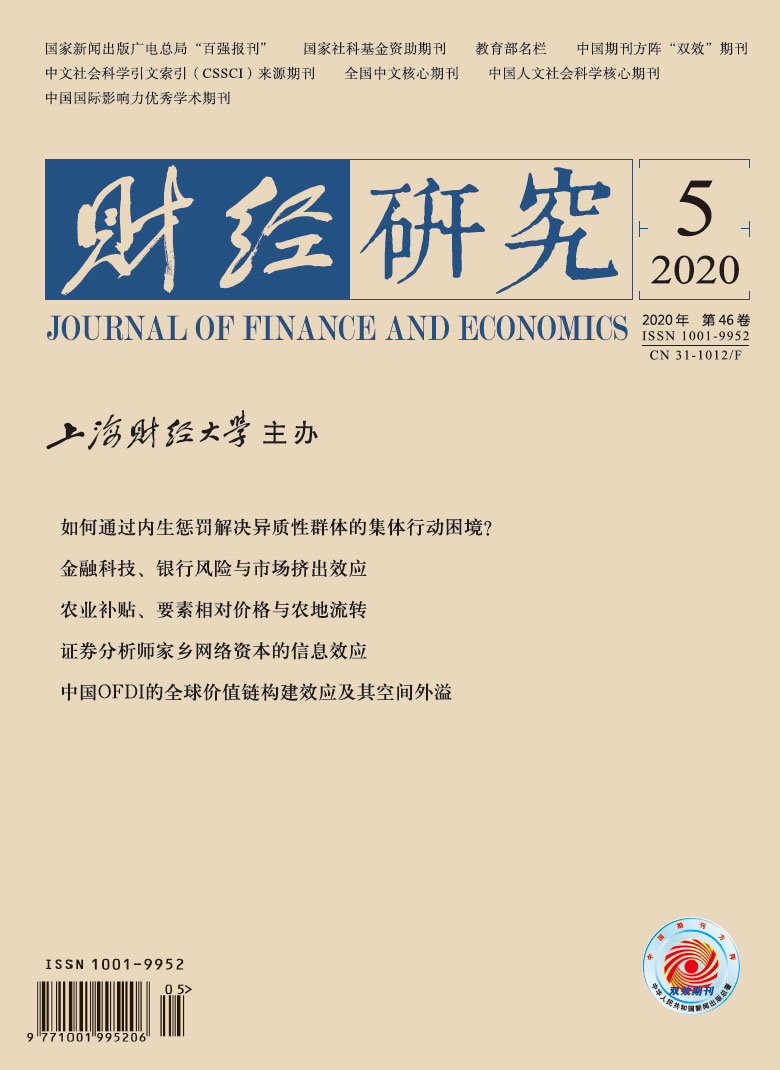中国的土地制度、家庭购房偏好和新房生产函数都不同于欧美国家,作为从宏观视角研究中国房地产经济的起点,需要利用中国数据校准或估计出一个参数更加可信的新房总量生产函数。为此,文章基于一个包含两个生产部门的动态随机一般均衡(DSGE)模型,尝试做了此项工作。基本模型分析表明,在中国新房生产中,土地、实物资本和劳动成本分别占23%、67%和10%;而在京沪等一线城市的新房生产成本中,土地接近30%,实物资本略超50%,劳动占20%。如果模型设定基本正确,那么中国房地产部门的统计数据可能存在系统性偏差,而且全国平均水平比京沪等一线城市更加严重。基于基本模型的模拟分析,文章强调对于当前的土地供给应“分城施策”,三四线城市短期内应适当减少土地供给以稳定地价和房价,而一二线城市长期应尽量增加土地供给以降低地价和房价。2020年3月12日,国务院印发《关于授权和委托用地审批权的决定》,进一步深化“放管服”改革,赋予省级人民政府更大的用地自主权,这更加有利于地方政府实施文章所提出的“分城施策”建议。
中国新房总量生产函数与土地供给政策变化效应
摘要
参考文献
摘要
关键词
4 高然,龚六堂. 土地财政、房地产需求冲击与经济波动[J]. 金融研究,2017,(4):32−45. DOI:10.3969/j.issn.1009-3109.2017.04.005
9 许志伟,林仁文. 我国总量生产函数的贝叶斯估计−基于动态随机一般均衡的视角[J]. 世界经济文汇,2011,(2):87−102. DOI:10.3969/j.issn.0488-6364.2011.02.006
13 An S,Schorfheide F. Bayesian analysis of DSGE models[J]. Econometric Reviews,2007,26(2−4): 113−172. DOI:10.1080/07474930701220071
14 Bernanke B S, Gertler M, Gilchrist S. The financial accelerator in a quantitative business cycle framework[A]. Taylor J B, Woodford M. Handbook of macroeconomics (Vol.1)[M]. Amsterdam: Elsevier, 1999.
15 Chang C, Chen K J, Waggoner D F, et al. Trends and cycles in China’s macroeconomy[A]. Eichenbaum M, Parker J A. NBER Macroeconomics Annual 2015[M]. University of Chicago Press, 2016.
16 Chen K J,Wen Y. The great housing boom of China[J]. American Economic Journal:Macroeconomics,2017,9(2): 73−114. DOI:10.1257/mac.20140234
17 Chow G C,Li K W. China’s economic growth:1952-2010[J]. Economic Development and Cultural Change,2002,51(1): 247−256. DOI:10.1086/344158
18 Hansen G D. Indivisible labor and the business cycle[J]. Journal of Monetary Economics,1985,16(3): 309−327. DOI:10.1016/0304-3932(85)90039-X
19 Iacoviello M,Stefano N. Housing market spillovers:Evidence from an estimated DSGE model[J]. American Economic Journal:Macroeconomics,2010,2(2): 125−164. DOI:10.1257/mac.2.2.125
20 Ireland P N. A method for taking models to the data[J]. Journal of Economic Dynamics and Control,2004,28(6): 1205−1226. DOI:10.1016/S0165-1889(03)00080-0
21 Kydland F E,Prescott E C. Time to build and aggregate fluctuations[J]. Econometrica,1982,50(6): 1345−1370. DOI:10.2307/1913386
22 Liu Z,Wang P F,Zha T. Land-price dynamics and macroeconomic fluctuations[J]. Econometrica,2013,81(3): 1147−1184. DOI:10.3982/ECTA8994
23 Miao J J,Wang P F. Asset bubbles and credit constraints[J]. American Economic Review,2018,108(9): 2590−2628. DOI:10.1257/aer.20160782
24 Piazzesi M, Schneider M. Housing and macroeconomics[A]. Taylor J B, Woodford M. Handbook of macroeconomics (Vol.2)[M]. Amsterdam: Elsevier, 2016.
25 Song Z,Storesletten K,Zilibotti F. Growing like China[J]. The American Economic Review,2011,101(1): 196−233. DOI:10.1257/aer.101.1.196
26 Wei S J,Zhang X B. The competitive saving motive:Evidence from rising sex ratios and savings rates in China[J]. Journal of Political Economy,2011,119(3): 511−564. DOI:10.1086/660887
引用本文
刘建丰, 潘英丽. 中国新房总量生产函数与土地供给政策变化效应[J]. 财经研究, 2020, 46(5): 94-110.
导出参考文献,格式为:






 4604
4604  4277
4277

